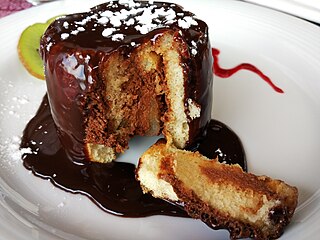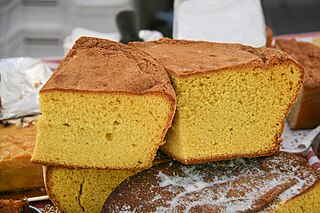Related Research Articles

Dessert is a course that concludes a meal. The course consists of sweet foods, such as candy, and possibly a beverage such as dessert wine and liqueur. Some cultures sweeten foods that are more commonly savory to create desserts. In some parts of the world there is no tradition of a dessert course to conclude a meal.

A mille-feuille, also known by the names Napoleon in North America, vanilla slice in the United Kingdom, and custard slice, is a French dessert made of puff pastry layered with pastry cream. Its modern form was influenced by improvements made by Marie-Antoine Carême.

Kuih are bite-sized snack or dessert foods commonly found in Southeast Asia and China. It is a fairly broad term which may include items that would be called cakes, cookies, dumplings, pudding, biscuits, or pastries in English and are usually made from rice or glutinous rice. In China, where the term originates from, kueh or koé (粿) in the Min Nan languages refers to snacks which are typically made from rice but can occasionally be made from other grains such as wheat. The term kuih is widely used in Malaysia, Brunei, and Singapore, kueh is used in Singapore and Indonesia, kue is used in Indonesia only, all three refer to sweet or savoury desserts.

A layer cake or sandwich cake is a cake consisting of multiple stacked sheets of cake, held together by frosting or another type of filling, such as jam or other preserves. Most cake recipes can be adapted for layer cakes; butter cakes and sponge cakes are common choices. Frequently, the cake is covered with icing, but sometimes, the sides are left undecorated, so that the filling and the number of layers are visible.

A Swiss roll, jelly roll, roll cake, cream roll, roulade or Swiss log is a type of rolled sponge cake filled with whipped cream, jam, or icing. The origins of the term are unclear; in spite of the name "Swiss roll", the cake is believed to have originated elsewhere in Central Europe, possibly Austria or Slovenia. It appears to have been invented in the nineteenth century, along with Battenberg cake, doughnuts, and Victoria sponge. In the U.S., commercial snack-sized versions of the cake are sold with the brand names Ho Hos, Yodels, Swiss Cake Rolls, and others. A type of roll cake called Yule log is traditionally served at Christmas.

A Boston cream pie is a cake with a cream filling. The dessert acquired its name when cakes and pies were cooked in the same pans, and the words were used interchangeably. In the late 19th century, this type of cake was variously called a "cream pie", a "chocolate cream pie", or a "custard cake".

A charlotte is a type of bread pudding that can be served hot or cold. It is also referred to as an "icebox cake". Bread, sponge cake, crumbs or biscuits/cookies are used to line a mold, which is then filled with a fruit puree or custard. The baked pudding could then be sprinkled with powdered sugar and glazed with a salamander, a red-hot iron plate attached to a long handle, though modern recipes would likely use more practical tools to achieve a similar effect.

Kue is an Indonesian bite-sized snack or dessert food. Kue is a fairly broad term in Indonesian to describe a wide variety of snacks including cakes, cookies, fritters, pies, scones, and patisserie. Kue are made from a variety of ingredients in various forms; some are steamed, fried or baked. Kue are popular snacks in Indonesia, which has the largest variety of kue. Because of the countries' historical colonial ties, Koeé (kue) is also popular in the Netherlands.

Bizcocho is the name given in the Spanish-speaking world to a wide range of pastries, cakes or cookies. The exact product to which the word bizcocho is applied varies widely depending on the region and country. For instance, in Spain bizcocho is exclusively used to refer to sponge cake. In Uruguay, most buttery flaky pastry including croissants are termed bizcocho, whilst sponge cake is called bizcochuelo. In Chile, the Dominican Republic and Bolivia bizcocho refers to a sweet dough (masa) baked with local ingredients, similar to the bizcocho from Spain. In Ecuador the dough of a bizcocho can either be sweet or salty. The US state New Mexico is unusual in using the diminutive form of the name, bizcochito, as the name for a locally developed and very popular cookie.

Dobos torte, also known as Dobosh, is a Hungarian sponge cake layered with chocolate buttercream and topped with caramel. The layered pastry is named after its inventor, Hungarian chef József C. Dobos, a delicatessen owner in Budapest. In the late 1800s, he decided to create a cake that would last longer than other pastries in an age when cooling techniques were limited. The round sides of the cake are coated with ground hazelnuts, chestnuts, walnuts, or almonds, and the hardened caramel top helps to prevent drying out, for a longer shelf life.
Cottage pudding is a traditional American dessert consisting of a plain, dense cake served with a sweet glaze or custard. The glaze is generally cornstarch based and flavored with sugar, vanilla, chocolate, butterscotch, or one of a variety of fruit flavors such as lemon or strawberry.

Sponge cake is a light cake made with egg whites, flour and sugar, sometimes leavened with baking powder. Some sponge cakes do not contain egg yolks, like angel food cake, but most of them do. Sponge cakes, leavened with beaten eggs, originated during the Renaissance, possibly in Spain. The sponge cake is thought to be one of the first non-yeasted cakes, and the earliest attested sponge cake recipe in English is found in a book by the English poet Gervase Markham, The English Huswife, Containing the Inward and Outward Virtues Which Ought to Be in a Complete Woman (1615). Still, the cake was much more like a cracker: thin and crispy. Sponge cakes became the cake recognised today when bakers started using beaten eggs as a rising agent in the mid-18th century. The Victorian creation of baking powder by English food manufacturer Alfred Bird in 1843 allowed the addition of butter to the traditional sponge recipe, resulting in the creation of the Victoria sponge. Cakes are available in many flavours and have many recipes as well. Sponge cakes have become snack cakes via the Twinkie.

Gâteau Basque is a traditional dessert from the Northern Basque region of France, typically filled with black cherry jam or pastry cream. Gâteau Basque with cream is more typical in the Southern Basque region of Spain.
The first season of The Great Canadian Baking Show premiered on CBC Television on November 1, 2017. Ten amateur bakers competed over eight weeks of challenges throughout the competition for the title.
Pie in American cuisine has roots in English cuisine and has evolved over centuries to adapt to American cultural tastes and ingredients. The creation of flaky pie crust shortened with lard is credited to American innovation.
References
- ↑ The Oxford Companion to Sugar and Sweets. pp. 69–70.
- ↑ What Constitutes Mysterious Washington Pie? The Washington Post, Washington, District of Columbia, 12 Apr 1908
- ↑ "Washington Cream Pie". Taste of Home.
- ↑ "Washington Pie". Farm and Dairy.
- ↑ Lewis, Tom (2015). Washington: A History of Our National City. Basic books.
- ↑ "On Presidents' Day, why not make a George Washington pie?". The Washington post.
- ↑ History of Washington Pie, The Morning Journal-Courier, New Haven, Connecticut, 19 Nov 1898
- ↑ "Celebrate Presidents' Day with Washington Cake or Washington Pie". Hudson Valley One.
- ↑ Nebraska State Historical Society Publications. Nebraska State Historical Society. 1907.
- ↑ Good Housekeeping , July 1901
- ↑ Cottage Pudding Proves Equally at Home in an Apartment or Fine Mansion, Detroit Free Press, Detroit, Michigan. 13 Feb 1934, Page 10,